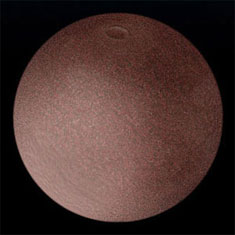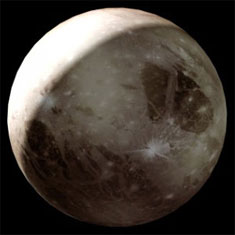- Dwarf Planets are a category of Solar System objects defined by the International Astronomical Union to be a body that is 1) in orbit around the Sun, 2) has sufficient mass to assume hydrostatic equilibrium (a nearly round shape), 3) has not cleared the neighborhood around its orbit, and 4) is not a planetary satellite.
- There are currently 5 objects classified as dwarf planets. They are Pluto, Ceres, Eris, Makemake, and Haumea.
- Pluto was once classified as a planet, however, it is now considered a dwarf planet since it fails to meet the third criterion above; i.e., it has not cleared area around its orbit.

- The largest of all the dwarf planets is Eris, even bigger than Pluto.
- The dwarf planet Ceres is found in the Asteroid Belt between the orbits of Mars and Jupiter.
- Vesta, another object found in the Asteroid Belt, is perhaps the next candidate to be classified as a dwarf planet. However, Vesta may not fulfill the second requirement in the definition above (having a nearly round shape) due to having been struck by an object after Vesta had formed.
- It is estimated that are as many as 200 dwarf planets in the Solar System.
Pluto Facts
Table of Contents
- Pluto was discovered in 1930 by Clyde Tombaugh.
- In 2006, Pluto was reclassified from a planet to a dwarf planet.
- It takes Pluto 248 (Earth) years to orbit the sun.
- Pluto has 5 known moons, called Charon, Nix, Hydra, S/2011 (134340) 1 and S/2012 (134340) 1. The latter two moons have not been given names yet.
- When Pluto was discovered, its small size surprised the scientific community, who had predicted Pluto to be as large as Jupiter.

- Pluto is so far from the Sun that the sunlight it receives has the same intensity as moonlight on Earth.
- The word “plutoid” is used to classify objects in the Solar System that are rounded and orbit the sun at a distance further away than Neptune. Currently, only 4 plutoids are recognized (Pluto, Eris, Haumea, and Makemake), but some astronomers believe there are over 70 more objects that should be plutoids and are waiting to be classified.
- Pluto and its moon Charon form a binary system, meaning that the center of mass of the two objects is outside of Pluto. Effectively, Pluto moves in small circles as Charon orbits it.
- Pluto’s orbit is chaotic, i.e. unpredictable. Scientists can predict the location of Pluto along its orbit for 10-20 million years, but after that it is unknown.
- It takes sunlight over 3 hours to reach the New Horizons mission flying to Pluto.
- The New Horizons mission has some of the ashes of Tombaugh (the astronomer who discovered Pluto) onboard the probe.
- Scientists believe that Pluto is made up of 50-70% rock and 30-50% ice by mass.
- Pluto is expected to have a solid rocky core, surrounded by a water-ice mantle and a frozen nitrogen surface.
- The core of Pluto is predicted to have a diameter of about 1,700 kilometers (1,000 miles), which is 70% of the total diameter of Pluto.
Pluto & Its Orbiting Bodies
The planet formerly known as Pluto has a few companions orbiting it. Because of all the hoopla of the recent classification of Pluto as a dwarf planet, there has been a lot of attention focused around this celestial body. Within the past year, two more satellites have joined an older discovery bringing the number of known celestial objects orbiting Pluto to three.
If you don’t know what a satellite is, at least when it pertains to a celestial body in the solar system, it is an object that orbits a body bigger than itself or a planet. It also cannot be man-made. Many satellites are often moons. In the case of Pluto, the three satellites refer to this dwarf planet’s three moons. They are called Charon, Nix, and Hydra. A man named James Christy, an American astronomer who worked at the United States Naval Observatory at the time, discovered Charon in the late 1970s. Nix and Hydra are fairly new additions to the Pluto companion line-up. The Hubble Telescope captured images of these two moons in May 2005.
Based on beginning observations of Nix and Hydra, scientists believe that they both orbit Pluto in a circular pattern within the same plane as Charon. In addition, scientists think that these two moons were probably formed around the same time period as Charon, possibly in the same event, a cosmic collision that probably occurred several billion years ago. The reasoning behind this hypothesis is that all three moons reflect the light in the same way. In other words, their indistinct color is vastly different from the reddish hue of Pluto. Because Pluto has Charon, Nix and Hydra orbiting it and there is the possibility of even more satellites as well, scientists have compared these celestial bodies to being a mini-solar system all on their own. In fact, scientists have called Pluto and its orbiting moons a Plutonian system. This Plutonian system has a very tight orbit.
Nix and Hydra have longer orbits around Pluto than Charon. In fact, Nix completes almost two orbits to Charon’s twelve orbits around Pluto. Hydra finishes almost three orbits in the same span of time. Quite a few scientists believe that there could be additional moons out there orbiting Pluto. Of course, while scientists formed this theory, they are also a bit confounded that this dwarf planet, which is only about seventy percent of the size of the Earth’s moon, could have all these celestial companions.
Before officially being christened with the names Nix and Hydra, these two newest Plutonian satellites were labeled P1 and P2. Scientists came up with the name Nix after the Greek goddess of the night named Nyx and who just happened to be the mother of Charon, the Greek figure that piloted the boat, which carried souls into the underworld. The name Hydra was derived from the mythological snake with nine heads that guarded the underworld. There is also another influence on the names as well. These two moons start with the letters “N” and “H” which are also the beginning letters of New Horizons, the spacecraft launched in 2005 that is headed towards the area of Pluto.
Scientists have several more years before the spacecraft New Horizons makes its way to the Plutonian system. Until then, they can only speculate about the three moons of the dwarf planet Pluto – Charon, Hix, and Hydra. The long trip to the Pluto area will help them gather data and bring new views to these satellites.
Eris Facts
On January 8, 2005, the planet, which is currently called 2003UB313, was found. It was later names as Eris.
It took a while for scientists to realize that this was indeed a planet. The time-lapse photograph, in which the new planet was discovered, was first shot in the year 2003. These pictures were taken with the Samuel Oschin Telescope at the Palomar Observatory near San Diego, California.
The images that were taken back in the year 2003 were taken approximately 90 minutes apart. In one photo the newly found planet is found moving amongst a sea of stars. Further studies are being done to learn about the properties of this newly found entity.
This new planet is one that is the furthest away from the sun, further away than others-three times further than Pluto. Therefore, this planet will most likely be very cold and dark, with temperatures comparable to Pluto and other planets. Finding this planet did not appear to be a planned activity.
One of the original photographs taken of the planet Eris (a.k.a. dwarf planet) shows this planet as mostly covered with darkness (as mentioned in the earlier paragraph). However, the part that is visible in the photo reveals the color scheme of this planet. It appears as that of a multi-colored marble and consists of a mixture of colors including pink, white, and possible green colors.
According to one source, the first discovery of the planet Eris includes M.E. Brown, C.A. Trujillo, and D.L. Rabinowitz. The date of the discovery according to one source is in the date 2003, but according to NASA scientists did not know that Eris existed at the time of the photo-taking.
The planet Eris is believed to be 2400 km approximately (give or take 100 km). This would be approximately 1500 miles around, give or take about 60 miles. The Hubble Telescope took this measurement in the year 2006.
Eris is considered the largest in a group of dwarf planets. Therefore, this planet has been officially named the solar system’s tenth planet. Furthermore, it joins Pluto and another planet named Ceres as a new group of planets called the dwarf planets. Mike Brown, one of the discoverers, designated this new label.
The diameter of Eris is about 19 percent that of the diameter of Earth. The mass and density of this planet are not set in stone yet but could be by the time this article is published.
It is also categorized as a trans-Neptunian object. This means that it orbits at a distance greater than that of the average of Neptune. It orbits the sun in a region known as the scattered disc, which is one of the three divisions of the volume of space where planets like Eris travels.
The planet of Eris is accompanied by at least one moon. Further studies are being done on the possibility of there being more moons that exist in the vicinity of this planet. Other studies are being conducted on the study of the new planet of Eris as well.
There is so much more to learn regarding Eris, as well as another aspect of the solar system. (You may want to study and find out why Ceres is not considered one of the main planets and Eris is, for instance). More articles like this may be posted soon regarding the planet Eris, as well as regarding other subjects pertaining to the solar system.
New discoveries are being made about the universe every single day. Further research is being done on the specific properties of the planet Eris.
